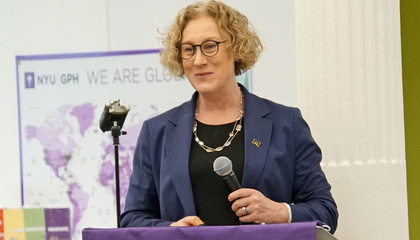Up until about ten years ago, it was politically taboo for academics to talk about firearm violence. Research wasn’t funded at the federal level, and you couldn’t present a poster or submit an article with the word “firearms” in the title. “It made people squeamish,” said Dr. Rebecca Cunningham, Vice President for Research at the University of Michigan. But after tragic shootings at schools in Sandy Hook, CT and Parkland, FL things began to change, and Dr. Cunningham is working at the forefront of that change. At a recent visit to NYU GPH she discussed rising levels of firearm injury among children and teens in the U.S., and she offered a path forward to a future of reduced gun violence and death.
Dr. Cunningham began by acknowledging the many forms of firearm violence: school shootings, intimate partner violence, community (mass) shootings, children unintentionally firing weapons, and suicide by gun, among others. And she described how people are affected by firearm violence regardless of their age, their politics, where they live, what they do, or what they believe in. Uniting these disparate groups is one commonality they can all agree on: fewer firearm injuries and deaths is a good thing. At the very least, she said, we should all be willing to talk about it, since silence solves nothing.
As a former emergency room physician, Dr. Cunningham said she wanted to move beyond treating victims one at a time -- to “work upstream,” so to speak, and figure out how to prevent violence before it happens. It sounds simple, but gun violence is an emotional topic, and people often want to jump to solutions. She’s often asked, “What’s the one thing we should do about firearm violence?” But that’s like saying “What’s the one way to fight cancer?” The problem is too complex and multifaceted for a single solution, so Dr. Cunningham emphasizes that any approach must be evidence-based: define the problem, develop good strategies, implement initiatives, and then monitor and evaluate effectiveness.
We also need to change the narrative, Dr. Cunningham said, and reframe the problem to emphasize “safety and harm reduction” -- not “gun control.” Nobody wants to be controlled! Swimming pools are risky but nobody is banning them. Cars can be dangerous, but we keep driving them. She underscored that respecting the views and values of people who do own firearms, and meeting them where they are, is key to building coalitions to prevent violence.
On a broader level, medical schools and health care organizations must better educate the next generation of professionals about trauma-informed care, put more money into research, and move beyond the clinic or hospital walls into community-based advocacy. Physicians should know not only the risk factors for firearm violence; they should also know how a firearm (e.g., a gunlock) works, how to screen patients, and how to effectively counsel them in every situation.
Dr. Cunningham also cited several examples of successful prevention initiatives, such as a four-item screener that predicts the likelihood of engaging in firearm interactions; a free, one-credit online course in injury prevention that’s funded by the NIH, and even greening projects -- cleaning up and planting empty lots -- that have been proven to decrease firearm assaults and robberies. She also discussed ERPO (Extreme Risk Protection Order) policies, known in some states as red flag laws.
Dr. Cunningham encouraged students and early-career professionals to consider applying their skills toward firearm injury prevention, saying that “it’s possible to witness palpable change over the course of your career.” She cited the dramatic reduction since 1999 in motor vehicle crashes -- not by taking away cars, but with a coordinated effort and a mix of solutions. Cars became safer with airbags and seat belt campaigns; roads became safer with improved lighting and signage; organizations like Mothers Against Drunk Driving drove behavioral change.
The result was an injury prevention success story, and Dr. Cunningham reiterated that the same can happen for firearm injury prevention. When people tell her that gun violence is not a solvable problem, she acknowledges that there’s more work to do, but reminds them that cholera, polio and rabies all seemed unsolvable at one time, too. “We have a lot of catching up to do, but we’re moving in the right direction,” she said. “Culture change is possible, and hope is not a strategy.”
The presentation was followed by a Q&A session that touched upon how hospitals are doing in terms of harm prevention; whether funding for research can come from other sources, such as the NRA and gun manufacturers; and what the tipping point was that spurred an increase in gathering data and funding research. To hear Dr. Cunningham’s answers, see her slides and watch her entire presentation, click on the video above.
